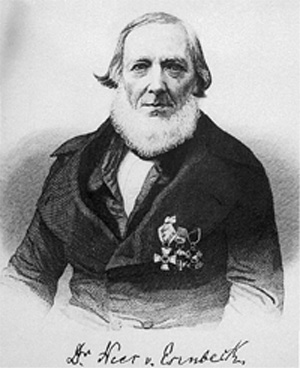Christian Gottfried Daniel Nees von Esenbeck

Christian Gottfried Daniel Nees von Esenbeck (February 14, 1776 - March 16, 1858) was a prolific German botanist, physician, zoologist, and natural philosopher. He was a contemporary of Goethe and was born within the lifetime of Linnaeus. He described approximately 7,000 plant species (almost as many as Linnaeus himself). His last official act as president of the German Academy of Natural Scientists Leopoldina was to admit Charles Darwin as a member. He was the author of numerous monographs on botany and zoology. His best-known works deal with fungi.
Biography
Nees von Esenbeck was born in Schloss Reichenberg near Reichelsheim (Odenwald). He showed an early interest in science and, after receiving his first education at Darmstadt, he went on to Jena, obtaining his degree in medicine in 1800. He practiced as a physician for a time, but he had developed a great interest in botany during his university studies, and eventually he returned to academia. In 1816 he joined the Leopoldina Academy, which was one of the most prestigious institutions in Europe. In 1817 he was appointed professor of botany in Erlangen. Three years later he became professor of natural history in Bonn, where he established the Botanische Gärten der Friedrich-Wilhelms-Universität Bonn, and in 1831 he was appointed to the chair of botany at the university of Breslau. In 1818 he was elected president of the Leopoldina Academy. He continued as president of the academy for the rest of his life.
In 1848 he became politically active. In 1851 due to conflicts with the government he was deprived of his professorship and pension at Breslau. Seven years later Nees von Esenbeck died essentially penniless in Breslau. He was an older brother to botanist Theodor Friedrich Ludwig Nees von Esenbeck (1787-1837).
Works
- De Cinnamomo disputatio (1843)
- Agrostologia brasiliensis (1829)
- Genera et species Asterearum (1833)
- Systema Laurinarum (1836)
- Florae Africae australioris illustration monographicae Gramineae (1841)
- Die Algen des süßen Wassers, nach ihren Entwickelungsstufen dargestellt (1814)
- Das System der Pilze und Schwämme (1816)
- Naturgeschichte der europäischen Lebermoose mit Erinnerungen aus dem Riesengebirge (1833-38, 4 Bände)
- Bryologia germanica (with Christian Friedrich Hornschuch und Jacob Sturm, 1823–31, 2 Bände mit 43 Tafeln)
- Synopsis hepaticarum (with Carl Moritz Gottsche und Johann Lindenberg, 1844–1847)
- Hymenopterorum Ichneumonibus affinium monographiae (1834, 2 Bände)
- System der spekulativen Philosophie, Band 1
- Die Naturphilosophie (1841)
- Die allgemeine Formenlehre der Natur (1852)
- Vorlesungen zur Entwickelungsgeschichte des magnetischen Schlafs und Traums (1820)
External links
- http://www.nees-von-esenbeck.de/ (German language site devoted to Nees von Esenbeck; includes extensive biography)
- "History". Nees-Institut für Biodiversität der Pflanzen. Retrieved 2008-07-24. Template:De icon
References
- This article incorporates text from a publication now in the public domain: Chisholm, Hugh, ed. (1911). Encyclopædia Britannica (11th ed.). Cambridge University Press.
{{cite encyclopedia}}: Missing or empty|title=(help) - Jahn: Geschichte der Biologie. Spektrum 2000
- Karl Mägdefrau: Geschichte der Botanik. Fischer 1992
- Bohley, Johanna: Christian Gottfried Daniel Nees von Esenbeck: ein Lebensbild. – Stuttgart: Wissenschaftl. VG, 2003. – ISBN 3-8047-2075-7
- Engelhardt, Dietrich von (Hrsg.): Christian Gottfried Nees von Esenbeck: Politik und Naturwissenschaft in der ersten Hälfte des 19. Jahrhunderts. – Stuttgart: Wissenschaftl. VG, 2004. – ISBN 3-8047-2153-2
